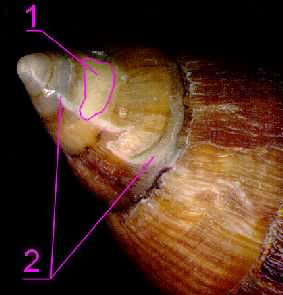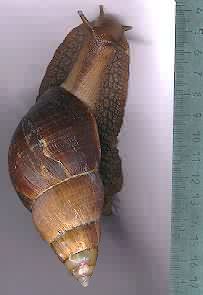On this web page I should like to place
information about possible medical treatment of snails.
The severest problem with snails’ health I confronted with was
the destruction of a shell. Such destructions can appear, for example, if snails fall to
the ground.
If only the edge of a shell is damaged, even very hard, a snail itself rather
quickly restores it. Such damages are not dangerous; only further, on this place on
surface of the shell there will be a roughness (strip).
It will be much worse if the shell is punched closer to top. The snail itself
cannot restore such damages.
It is absolutely bad, if the shell is completely broken.
Snails’ shells jobbing
All manipulations should be carried out with observance of
cleanliness and accuracy.
Clear the damaged place of dirt and particles of the broken shell. If soiling is
strong, wash this place out, carefully immersing a snail in water (+25-30 degrees
Celsius).
Cover this aperture in damaged shell using thick plaster and suitable (plastic or
metal) an elastic plate. Do not try to do a layer of plaster too thick and do not push it
inside because it can squeeze internal organs of a snail. Remove the surplus of plaster.
The shell must be dry and clean during the whole period of restoration lasted.
In 2-3 hours after hardening and drying of plaster, put on plaster and a shell
around it a layer of correctly prepared epoxy resin (glue). I used epoxy resin
"EDP" (Russian name).
It is the most tiresome part! Don’t let epoxy resin contact the body of a snail.
Note, that epoxy resin dries up during long time and also trickle down. Probably, you’ll
have to rotate a snail, slowly and cautiously, and carefully wipe up epoxy resin. In some
hours epoxy resin will lose its fluidity and will start to harden. While epoxy resin
remains fluid, it is toxic for you and for a snail (see the instruction to resin)!
In 6-7 hours the snail can be placed in a separate terrarium with small humidity
and without capacities with water.
In a day epoxy resin will harden completely, and the snail can be kept as usually.
 
This is a top of a shell after restoration:
1- the aperture is covered with plaster, under a layer of epoxy resin, 2- hardened epoxy
resin.
On the right - the same snail, after half a year.
I successfully restored snails’ shells damaged closer to top.
All snails, after the restoration procedures are alive, healthy, they grow and breed
already about one year.
Dried up epoxy resin is nontoxical, hold on properly and abrasion resisten.
Probably, this or similar method can be applied in more complicated situations,
which fortunately did not happen to my snails.
It seems to me, it’s better not to use plaster if damages are big. It is better
to try a foil, a tin and a wire, plastic. Then to cover them by epoxy resin or cloth
impregnated with epoxy resin.
|



![]()

